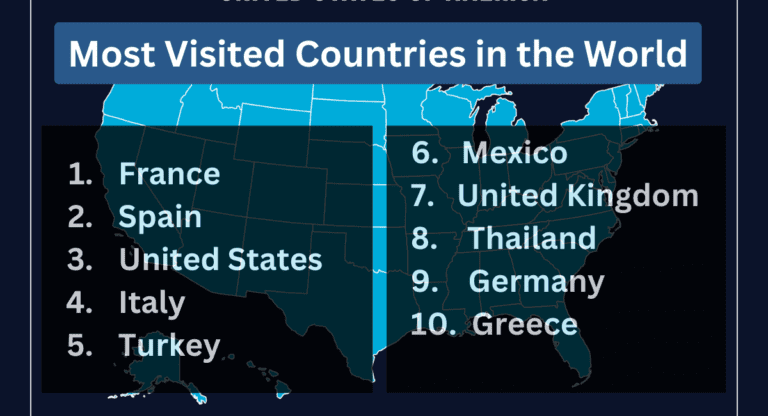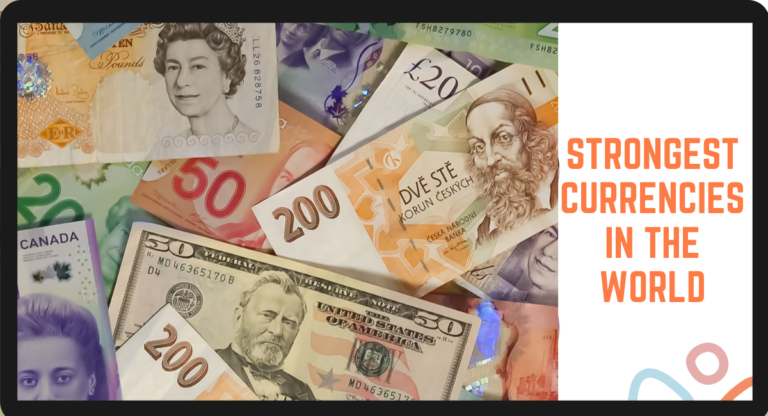Which Are the 8 Most Traded Currencies in the World in 2024?
In 2024, the global finance arena is steered by a select group of currencies that dominate international trade and investment. Known as the most traded currencies, these financial giants are crucial to the stability and efficiency of the global economy. Trillions of dollars flow through their channels daily, facilitating transactions that impact markets and economies worldwide.
In this article, we will delve into the histories, evolutions, and current influences of these dominant currencies, shedding light on their significance in shaping the modern financial landscape. Discover the stories behind the most traded currencies and their pivotal roles in maintaining the pulse of global trade and investment.
A List of the 8 Most Traded Currencies Worldwide in 2024
Below is a list of the most traded currencies worldwide.
- US Dollar (USD)
- Euro (EUR)
- Japanese Yen (JPY)
- British Pound (GBP)
- Australian Dollar (AUD)
- Canadian Dollar (CAD)
- Swiss Franc (CHF)
- Chinese Yuan (CNY)
1. US Dollar (USD)
The United States dollar (USD) has been the world’s most-traded currency for decades, tracing its origins back to the early days of the United States. The Coinage Act of 1792 introduced the dollar, establishing it as the basic unit of money and creating the United States Mint. Initially, the dollar was tied to a bimetallic standard, exchangeable for silver or gold, until the U.S. shifted to a gold standard in 1837. The Gold Standard Act of 1900 fixed the dollar’s value at $20.67 per troy ounce of gold, later adjusted to $35 per troy ounce in 1934.
The Nixon Shock of 1971 marked a dramatic shift, when the United States abolished the gold standard and allowed the dollar to fluctuate freely on the foreign exchange market. This move transformed the dollar into a fiat currency, with its value determined by market supply and demand.
Today, the dollar is the primary reserve currency held by governments worldwide for international trade, representing about 88% of all forex trades, according to the Bank of International Settlements. Commodities like gold and oil are predominantly traded in dollars, benefiting the U.S. by reducing balance-of-payments crises and enhancing economic stability.
However, the dollar’s dominance also poses challenges, potentially causing instability in emerging markets and impacting global trade flows. The rise of digital currencies and the increasing prominence of the Chinese yuan could challenge the dollar’s dominance. Despite these challenges, the dollar’s influence is likely to endure, supported by the U.S.’s robust capital markets and its status as the world’s largest economy.
Also Read: Strongest Currencies in the World
2. Euro (EUR)
The Euro (EUR) is the official currency of the European Union (EU) and has been a pivotal force in the global financial arena since its inception in 1999. As the second most widely traded currency in the world, the Euro plays a critical role in shaping international economic relations and ensuring the stability and growth of the global financial system.
The Euro was introduced as a virtual currency on January 1, 1999, with the aim of creating a unified economic and monetary union among EU member states. By 2024, 20 out of 27 EU member states use the Euro for trade and daily transactions. The currency initially facilitated electronic transactions and later, in 2002, was circulated in the form of physical notes and coins. This move marked a significant step towards the EU’s objective of establishing a more integrated and cohesive economic space.
Over the years, the Euro has grown in economic influence and global stature. While initially perceived as a rival to the US dollar, it has become a complementary currency, frequently used alongside the dollar in international transactions. The Euro’s reach extends beyond the EU, with numerous countries holding substantial reserves of the currency. Its stability and liquidity make it an attractive option for international investors and a preferred reserve currency for central banks worldwide.
However, the Euro faces challenges, particularly from economic uncertainties spurred by the COVID-19 pandemic. The economic downturn has impacted its value, and the EU’s recovery is closely linked to the economic health of major trading partners like the United States and the United Kingdom. Despite these challenges, the Euro offers significant growth opportunities. The EU’s recovery strategy focuses on investments in digital infrastructure, renewable energy, and sustainable technologies, which are expected to drive economic growth and contribute to a more sustainable global economy.
3. Japanese Yen (JPY)
The Japanese Yen (JPY) is the third most widely traded currency in the world. Its origins date back to 1871, a period marked by significant monetary reforms in Japan aimed at modernizing the country’s financial system. Initially pegged to gold and silver, the yen was designed to stabilize trade and foster economic growth. By 1933, it was linked to the US dollar, and in 1973, it transitioned to a freely convertible currency.
Today, the yen constitutes approximately 8.5% of global trading volume, reflecting Japan’s significant role in the global economy as a leading exporter. The yen’s value is influenced by various economic indicators, such as GDP growth, which can lead to its appreciation. Additionally, the Bank of Japan’s (BoJ) monetary policies play a crucial role in shaping the Yen’s value as they address inflation, economic growth, and currency volatility.
In recent years, the Yen has fluctuated due to divergent global monetary policies, international crises, and domestic economic challenges. For instance, the Yen’s depreciation in 2023 underscored Japan’s economic vulnerabilities and the impact of global market uncertainties.
Despite these fluctuations, the Yen remains a key world reserve currency, with central banks and international financial institutions holding substantial amounts. This stability is bolstered by Japan’s strong current account surplus and significant global investment activity by Japanese companies, which benefit from substantial revenues generated by exports.
4. British Pound (GBP)
The British Pound (GBP) boasts a rich history dating back to the 8th century when it first emerged as a unit of account in England. Over the centuries, the pound has undergone several transformations, including its adoption of the gold standard in the late 19th century and its subsequent abandonment during World War I.
From 1944 to 1971, the Pound was pegged to the US dollar under the Bretton Woods system. Since the end of this system, the pound has operated as a free-floating currency, its value determined by market forces of supply and demand.
The pound’s value experienced significant volatility, particularly following the 2008 global financial crisis. It fell sharply against the US dollar, dropping from a high of $2.05 in 2007 to a low of $1.35 in 2009, driven by economic challenges in the UK, such as high inflation and a substantial budget deficit.
The pound has recovered significantly in recent years, thanks to strong economic development in the United Kingdom and proactive monetary policy from the Bank of England. However, Brexit has introduced additional volatility, impacting the pound’s stability as the UK’s exit from the European Union led to increased uncertainty in currency markets.
As of 2024, the British Pound remains one of the most widely traded currencies globally, playing a crucial role in international finance and trade, especially in energy and commodities markets. Despite its significant influence, the pound faces ongoing challenges, including Brexit-related uncertainties and shifts in global economic conditions, such as trade tensions between major economies like the US and China.
Also Read: Richest Countries in the World
5. Australian Dollar (AUD)
In 1966, the Australian dollar (AUD) replaced the Australian pound at an exchange rate of 2 AUD per pound. The Australian dollar was initially fixed to the British pound before switching to a floating exchange rate regime in 1983, allowing it to respond more dynamically to market conditions.
A range of factors, including interest rate differentials, commodity prices, economic performance, and global economic conditions, influence the AUD’s value. As a significant commodity exporter, Australia’s currency frequently fluctuates in response to global resource prices such as iron ore, coal, and natural gas. When commodity prices rise, the AUD typically strengthens, while declines in prices can lead to depreciation.
From 2019 to 2023, the Australian dollar faced challenges due to a mix of domestic and international variables. The COVID-19 pandemic notably affected its performance, but as global markets recovered, the AUD rebounded strongly. The Reserve Bank of Australia’s monetary policy, especially interest rate changes, continues to play a significant role in shaping the AUD’s value.
Despite its fluctuations, the AUD presents opportunities for investors and traders. Its strong correlation with commodity prices makes it an attractive currency for those looking to capitalize on market movements in resources. However, the AUD must navigate potential challenges such as shifts in global economic conditions, trade tensions, and volatility in commodity prices, which could impact its performance in the international market.
6. Canadian Dollar (CAD)
The Canadian Dollar (CAD) has a rich history that mirrors Canada’s economic evolution and its rise from a colonial outpost to a prominent global economy. The history of the CAD began in the 17th century, when European fur traders founded trading posts in North America. Following the British conquest of New France in 1763, the British pound became the official currency in Canada.
A significant milestone came in 1792 with the introduction of the Halifax Merchant’s Tokens, marking the beginning of the official Canadian currency distinct from the British pound. The formation of the Province of Canada in 1841 set the stage for the creation of the Canadian dollar in 1867. Beginning in 1871, the CAD was linked to gold, followed by the introduction of Canadian dollar banknotes. The formation of the Bank of Canada in 1935 increased Canada’s control over its monetary policies.
Today, the Canadian dollar stands as the sixth most traded currency globally, reflecting Canada’s economic stability and growth. The country’s abundant natural resources, especially oil, play a crucial role in its economy. Canada’s status as a major commodity exporter has earned the CAD the nickname of a “petrocurrency,” indicating its sensitivity to fluctuations in oil prices and export volumes.
The CAD’s evolution from a colonial currency to a significant global player highlights Canada’s economic development and its growing influence in the international financial landscape.
7. Swiss Franc (CHF)
The Swiss Franc (CHF), often referred to as the “Swissie,” is renowned for its stability, security, and status as a haven for investors amid global economic turmoil. The CHF’s image as a safe-haven currency is well-deserved, given that it is the only franc remaining in circulation in Europe (other countries having embraced the Euro).
Switzerland’s neutrality, political stability, low inflation, strong legal framework and status as one of the richest countries in Europe contribute to the CHF’s reliability. The country’s independent stance on foreign affairs and its robust, Western-oriented business environment further bolster the franc’s attractiveness to investors seeking safety during uncertain times.
The Swiss Franc, as the world’s seventh most traded currency, has a substantial impact on worldwide finance. Its stability makes it a preferred asset during periods of geopolitical or economic instability. However, the CHF faces challenges that could affect its value and market position. A notable concern is its high value, which can make Swiss exports and tourism more expensive, potentially impacting Switzerland’s trade balance and economic growth. Conversely, this high value makes foreign goods cheaper for Swiss consumers.
Despite these challenges, the CHF’s status as a safe-haven currency offers growth and investment opportunities. During crises or periods of economic uncertainty, investors flock to the CHF, increasing its demand and driving up its value. Thus, while the Swiss Franc navigates challenges, its role as a secure asset continues to provide significant advantages in global financial markets.
8. Chinese Yuan (CNY)
The Chinese Yuan (CNY), introduced in the late 1800s, has undergone significant evolution to become a prominent global currency. Initially, China maintained a fixed exchange rate system, linking its currency to other major global currencies. In 2005, China shifted to a floating exchange rate regime, allowing the Yuan’s value to fluctuate based on market demand and supply.
China’s economic expansion and globalization efforts have propelled the Yuan into a more significant role in the foreign exchange market. The currency’s inclusion in major global currency baskets, bilateral currency swaps, and trade settlement agreements has bolstered its credibility and acceptance as a global reserve currency. As a result, both onshore (CNY) and offshore (CNH) markets have seen increased trading volumes, with the Yuan becoming actively used in cross-border transactions and investments.
Despite its progress, the Yuan faces several challenges. The central bank’s strict control over the currency, capital controls that restrict capital flow, and trading range limitations hinder its full potential on the global stage. These factors contribute to its complex status in the forex market.
Nevertheless, the Yuan’s growing influence and its role in challenging the US Dollar’s dominance highlight opportunities for further integration into the global currency market. The trend toward de-dollarization in international trade and finance presents additional prospects for the Yuan to solidify its position as a key player in global finance.
Final Words
In conclusion, the global currency landscape is shaped by a diverse array of influential currencies, each with unique histories and characteristics. From the enduring dominance of the US Dollar and the robust stability of the Swiss Franc to the evolving prominence of the Chinese Yuan and the economic significance of the Euro, these most traded currencies play a crucial role in the international financial system. As these currencies navigate challenges and opportunities, their impact on global trade, investment, and economic stability remains profound.
FAQs
Which Currency Is Currently the Most Traded?
The US dollar is the most traded currency in the forex market, commanding a daily average trading volume of approximately $6.6 trillion. Its dominance is so pronounced that all ‘major’ currency pairs in forex trading include the USD.
What Is the Strongest Currency in the World in 2024?
As of 2024, the strongest currency in the world is the Kuwaiti Dinar (KWD). With an exchange rate of approximately 3.26 US dollars per dinar, the Kuwaiti Dinar holds the highest value relative to the US dollar. This strength is attributed to Kuwait’s significant oil reserves, which play a crucial role in its economy. The currency’s high value is supported by Kuwait’s robust economic fundamentals, including substantial trade surpluses and a stable financial environment. As a result, the Kuwaiti Dinar stands out as the strongest currency in terms of its value against the US dollar.
What Is the Universal Currency?
The most universal currency is the US dollar (USD). As the world’s primary reserve currency, it is widely held by central banks and commercial banks globally. Its dominance is reflected in its significant role in international finance, with the US dollar accounting for approximately 88.3% of daily trades in the foreign exchange market. This extensive adoption underscores the dollar’s central role in global trade and investment.
Which Currency Is Considered the Safest?
The safest currencies are the Swiss Franc (CHF), Norwegian Krone (NOK), and Singapore Dollar (SGD). These currencies are highly regarded for their stability, supported by their countries’ strong political and economic systems.

I’m Sophia Jones, an adventurer at heart from New York City, USA. I live for travel and exploration, always eager to discover new places, meet fascinating people, and try out diverse cuisines. Over the past few years, I’ve traveled to numerous countries, immersing myself in different cultures and creating unforgettable memories.






